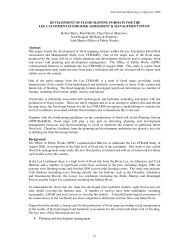Vegetation (Floating River Vegetation) - Office of Public Works
Vegetation (Floating River Vegetation) - Office of Public Works
Vegetation (Floating River Vegetation) - Office of Public Works
You also want an ePaper? Increase the reach of your titles
YUMPU automatically turns print PDFs into web optimized ePapers that Google loves.
2.3.4 Site integrity <strong>of</strong> the Lower <strong>River</strong> Shannon SAC survey square.<br />
Improved grasslands were the dominant habitat type <strong>of</strong> the Mulkear <strong>River</strong> banks. In urban<br />
areas amenity grassland (GA2) was the primary improved grassland habitat with improved<br />
agriculture grassland (GA1) more prevalent in rural areas. Riparian woodland (WN5) was the<br />
dominant woodland habitat along the rivers surveyed.<br />
The <strong>River</strong> Maigue at this point is the lower part <strong>of</strong> the river as it flows into the Shannon<br />
estuary. As the lower reach <strong>of</strong> the river is influenced by the tide the river is a tidal river (CW1)<br />
rather than a freshwater upland eroding watercourse (FW1) or lowland depositing watercourse<br />
(FW2). The presence <strong>of</strong> reed and large sedge swamps (FS1) on the river margin is typical <strong>of</strong> tidal<br />
river habitat in this square.<br />
A variety <strong>of</strong> habitats were observed on the riverbanks in the <strong>River</strong> Feale Square. The built<br />
environment (BL3), scrub (WS1) and hedgerows (WL1) were the dominant habitat types. Conifer<br />
plantations were evident in upland areas (WD4) while earth banks (BL2) were associated with a<br />
lowland river. Earth banks are this case is most likely the result <strong>of</strong> previous river maintenance<br />
works rather than the traditional earth banks used as field boundaries found in Co. Kerry.<br />
2.3.5 Site integrity <strong>of</strong> the Bandon <strong>River</strong> SAC survey square.<br />
Wet willow-alder-ash woodland (WN6) and wet pedunculate-oak-ash woodland (WN4) are<br />
the two habitat woodland types used to describe a section <strong>of</strong> woodland heading south along the<br />
Bandon <strong>River</strong>. Oak was not observed from the survey point within the wood but the woodland floor<br />
flora and tree diversity was similar to that described as wet pedunculate-oak-ash woodland.<br />
Alternatively, ash was a dominant tree species the habitat may be classified as wet-willow-alder-ash<br />
woodland. For the purpose <strong>of</strong> this study the habitat type is woodland with characteristics belonging<br />
to more than one woodland grouping. The two woodland types are used to describe the habitat.<br />
2.4 Identify other linked environmentally sensitive aspects.<br />
Described in this section are observations <strong>of</strong> an environmental nature that have an impact on<br />
floating river vegetation. Issues discussed will include invasive terrestrial plant species<br />
Rhododendron, Japanese Knotweed, Indian Balsam and Giant hogweed. Problematic species<br />
associated with aquatic environments include Parrot’s feather milfoil (Myriophyllum aquaticum)<br />
and algae. The ability <strong>of</strong> cattle to walk into rivers and streams also needs to be mentioned.<br />
At least one invasive / alien plant species was observed in each <strong>River</strong> square surveyed with<br />
all four species recorded in the <strong>River</strong> Feale square. The presence <strong>of</strong> Japanese knotweed colonising<br />
large stretches <strong>of</strong> riverbanks was especially worrying. Currently, the plant poses a threat to the<br />
ecological diversity to both aquatic and terrestrial systems and should the plant go unchecked, all<br />
11

















